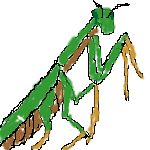|
Some boys really liked catching a praying mantis for fun. But, frankly, I was kind of scared of it. So, I tried not to get closer to it as far as the situation permitted. (As you know, boys sometimes need to show off so as not to be teased.) I was bit by a praying mantis a couple of times when I reached it, and that hurt me. Besides, its appearance seemed to me to somehow warn us to back off of it. Its triangular head reminded me of a poisonous snake, and those sharp saw tooth-like edges attached to its legs gave me severe pain whenever I tried to grab it. Part of my fear may have come from the Japanese name of this insect. It is called kamakiri, which literally means a sickle bug. Probably, its two big front legs reminded ancient Japanese of a dangerous sharp sickle. An interesting thing is that the same two front legs of this insect reminded ancient Greeks of a prophet praying for gods, from which came the English word praying mantis. Mantis meant a prophet in ancient Greek. So, Europeans seem to have seen some kind of divinity in the appearance of a praying mantis. As a matter of fact, however, female mantises are known to eat their male partners. So, I am wondering how people in the Western World are balancing betweem these two opposite images of a mantis. Mantis is also called mantid in English, which came from the Latin word mantidae (which again means prophets). For more information on the praying mantis, visit the Ohio State University entomology site. Also, visit the Birdwatcher's Digest site to observe a wild feature of this insect on photos. |
 |
| Kids' Home | News | Songs | Quizes | Opinions | Questions? |
| Last Update: 03/26/2019 | http://yocoelacademy604.sakura.ne.jp | Contact me |